History of Vladimir
Foundation of Vladimir
The first people began to settle in the territory of today’s Vladimir in the Paleolithic era, about 34 thousand years ago. In the 6th-7th centuries, the Volga-Finnish tribe of Merya settled here. In the 8th-10th centuries, on the hill where the Assumption Cathedral was later built, there had been a Meryan settlement. In the 9th-10th centuries, the Slavs began to settle here, in particular, the Krivichi.
There are two alternative years for the founding of Vladimir: 1108 and 990. In the Soviet period, the version was accepted that Vladimir had been founded by Prince Vladimir Monomakh around 1108. Accordingly, the 850th anniversary of the city was celebrated in 1958. In the 1990s, local historians, based on a number of chronicle sources, spoke in favor of another year of the city’s foundation - 990. And another Vladimir was named the founder of the city - Prince Vladimir Svyatoslavich, also known as Vladimir the Great (Christianized the Kievan Rus in 988).
Vladimir grew thanks to the princes Vladimir Monomakh (1053-1125) and Yuri Dolgoruky (1090-1157), who strengthened it as a stronghold for the defense of the Rostov-Suzdal principality. Prince Andrey Bogolyubsky (1111-1174) transferred the capital of the principality to Vladimir in 1157. In this town, as the new capital of North-Eastern Russia, the Assumption Cathedral was erected in 1158-1160. The Golden Gate (built around 1164) became the key point of the town’s defense.
Under the successors of Prince Andrei Bogolyubsky, the town expanded greatly. In Vladimir and neighboring Suzdal, the Vladimir-Suzdal icon-painting school was formed; the town had its own chronicle. The Vladimir principality reached its highest power during the reign of Prince Vsevolod the Big Nest (1176-1212), when the Cathedral of Saint Demetrius (1194-1197) was built.
More Historical Facts…
Vladimir in the 13th-17th centuries
In 1238, during the Mongol invasion of Rus’ (1237-1240), Vladimir was taken after a short siege and plundered. The princes of Vladimir were recognized in the Golden Horde by their status as the chief and oldest in all of Rus’. Vladimir remained the capital of the Russian lands. The status of the town increased in 1299, when it became the residence of the Russian metropolitans.
At the beginning of the 14th century, a struggle for control over the Vladimir principality unfolded between Tver, Suzdal and Moscow. In 1325, under Grand Duke of Moscow Ivan Kalita, Metropolitan Peter moved from Vladimir to Moscow, which strengthened the Moscow principality as a contender for the unifier of the Russian lands.
Subsequently, the Moscow prince Dmitry Donskoy (1350-1389) managed to achieve recognition of his hereditary rights to Vladimir from all neighboring princes and the Golden Horde, which meant his recognition as the Grand Duke of Vladimir and Moscow. This meant the annexation of the Vladimir lands to the Moscow principality.
In 1382, Vladimir, like other towns of North-Eastern Rus’, suffered from the invasion of Khan Tokhtamysh of the Golden Horde. In 1395, during the military campaign of Timur against Tokhtamysh, the miraculous and especially revered icon of the Vladimir Mother of God was brought to Moscow from Vladimir to protect it from the conqueror. The fact that the troops of Timur, for no apparent reason, turned back near Yelets (about 400 km south of Moscow), was regarded as the intercession of the Mother of God and the icon was not returned to Vladimir.
With the growth of Moscow, Vladimir turned into an ordinary provincial town. In 1614, the population of the town was only about 600 people.
Vladimir in the 18th - early 20th centuries
Some economic and cultural upsurge of Vladimir began at the end of the 18th century, when it became the administrative center of the Vladimir Governorate. In 1784, the population of Vladimir was about 2,500 people. In November 1797, the first printing house in Vladimir was opened, in January 1834 - the first provincial public library, in 1847 - a drama theater, in 1862 - a provincial museum of local lore.
In 1838-1840, Alexander Herzen, “the father of Russian socialism”, was in exile in Vladimir. In 1861, Vladimir was connected to Moscow by railway (Moscow-Nizhny Novgorod railway). In 1858, a telegraph began to operate in the town, in 1866, the construction of a water supply was completed, and in 1887, a telephone connection was established. In 1908, the first power plant was put into operation.
According to the first all-Russian census of 1897, 28,479 people lived in Vladimir: Russians - 26,436, Poles - 736, Ukrainians - 488, Jews - 399. At the end of the 19th century, a Lutheran church and a Catholic church were built in Vladimir.
At the turn of the centuries, the Russian Revival style of Russian architecture spread in Vladimir, the most striking examples of which were the Church of the Archangel Michael (1893) and the building of the Vladimir Historical Museum (1903). In 1914, the population of Vladimir was 47,020 people.
In the first years of Soviet power, many streets of Vladimir were renamed, most of the churches were closed and demolished. Two decades before World War II were the time of accelerated industrialization and the transformation of the city into a large industrial center.
On January 14, 1929, during the territorial and administrative reform, Vladimir became part of the newly formed Ivanovo Industrial Oblast. On March 5, 1932, the plant “Khimplastmass” (the Vladimir Chemical Plant) began operation. In 1939, the population of Vladimir was 66,797 people.
Vladimir during and after World War II
During the Second World War, Vladimir was one of the largest evacuation centers in the European part of the USSR. In 1941-1945, there were 18 evacuation hospitals in the city. In the fall of 1941, a lot of refugees came to Vladimir from Moscow and the Moscow region; they were leaving to the east from the German offensive. On August 14, 1944, Vladimir again became the center of a separate region - Vladimir Oblast.
In the first post-war years, there were three camps and a hospital for prisoners of war in Vladimir. The largest of them was Camp #190, which also had branches in the towns and villages of the region. In 1946, there were about 10 thousand people in this camp. By 1949, all prisoners of war returned to Germany.
After the war, large enterprises of machine-building, metal-working, electrical, instrument-making, chemical, and light industries were built in the city. In August 1958, a solemn celebration of the 850th anniversary of Vladimir took place. By the end of the 1950s, the city’s population exceeded 150 thousand people.
In 1960, the construction of an arched reinforced concrete bridge was completed - the first permanent bridge across the Klyazma, which made it possible to start the construction of a residential district (Zagorodny Park) and a regional hospital center on the right bank of the river.
In the early 1970s, Vladimir became one of the centers of the Golden Ring of Russia - a well-known tourist theme-route uniting several old Russian cities. In 1980, the population of Vladimir exceeded 300 thousand people.
Architecture of Vladimir
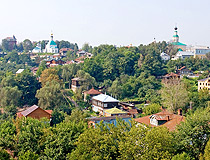
Cityscape of the old Vladimir
Author: Sergey Ashmarin

In the center of Vladimir on a holiday
Author: Boris Shmelyov
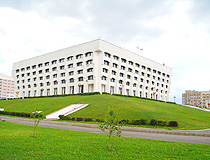
Vladimir Oblast Administration known as the White House
Author: Catherina Zhigunova
Vladimir - Features
In the past, such variants of the name of the city as Vladimir-on-Klyazma and Vladimir-Zalessky were also used in connection with the existence of the town of the same name in South-Western Rus’ (Vladimir-Volynsky in Volyn Oblast of today’s Ukraine).
Today’s coat of arms of Vladimir repeats its historical coat of arms with the following description: “In the red field, a lion standing on its hind legs with an iron crown on its head, holding a long silver cross in its front right paw.”
The oldest central part of Vladimir lies on the high left bank of the Klyazma River, on hills steeply descending to the river, separated by deep ravines. The Klyazma flows through the city for 2.5 km and another 5 km along the city border; the width of the river in Vladimir is about 130 m.
The climate in Vladimir is moderately continental. Winters are moderately cold, with alternating periods of frosts and thaws. Summers are warm, but relatively short, with occasional periods of extreme heat. The average temperature in January is minus 9.8 degrees Celsius, in July - plus 19.8 degrees Celsius.
Vladimir is an important industrial center of Central Russia. Large enterprises of machine-building, metal-working, electrical, instrument-making, chemical, light and food industries, and the construction industry operate in the city.
Public transport is represented by trolleybuses and buses. There are regular buses running from Vladimir to all district centers of Vladimir Oblast, as well as to Moscow, Ivanovo, Kostroma, Nizhny Novgorod, Ryazan, Yaroslavl, and other cities. Vladimir is connected by railway with Moscow and Nizhny Novgorod.
First and foremost Vladimir is a city-museum with unique historical and architectural monuments - three white-stone monuments of pre-Mongol architecture, recognized as a UNESCO World Heritage Site as part of the object “The white-stone monuments of Vladimir and Suzdal”. These are the Assumption Cathedral (1158-1189), Dmitrievsky Cathedral (1194-1197), and the Golden Gate (1158-1164).
In comparison with other cities of the “Golden Ring”, churches of the 17th-18th centuries in Vladimir are not so numerous. In architectural terms, the most interesting are the Church of the Assumption of the Blessed Virgin Mary (1649), Church of St. Nicholas the Wonderworker (1732-1735), and Church of the Beheading of John the Baptist (1762-1765), commonly known as Nikitskaya Church.
The pseudo-Gothic Catholic Church of St. Rosary, built in 1894, is worth mentioning among the monuments of the late 19th century. In total, there are more than 200 state-protected buildings of the 18th-19th centuries in Vladimir. After 1917, the historic city center was almost completely rebuilt.
Walking is the easiest and most comfortable way to explore Vladimir. Its compact historic center can be walked through in about 30-40 minutes. Souvenirs can be bought in one of the shops of the Trading Rows (Bolshaya Moskovskaya Street, 19), as well as from the stalls at the Golden Gate or the Dmitrievsky Cathedral. For authentic gifts, you should visit the shop at the Museum of Crystal and Lacquer Miniatures in the Trinity Church (Dvoryanskaya Street, 2).
You can buy souvenirs with images of Vladimir architectural monuments (plates, boxes, paintings, etc.), Pokrovsky gingerbread, Mstersk lacquer miniature, crystal from Gus-Khrustalny. Such birch bark products as boxes and sandals (lapti) are also popular, as well as all kinds of scarves, towels, patchwork, and stone jewelry.
Main Attractions of Vladimir
The Golden Gate (1158-1164) - one of the main symbols of Vladimir, the only one of the surviving gates in the earthen rampart that encircled old Vladimir. In the 12th century, this gate served as the main entrance for the prince and his retinue to the central part of the town. The Golden Gate got its name because in the past the gates were sheathed with gilded copper sheets. At the top of the structure there is a small chapel.
This unique example of the architecture of Kievan Rus’ is included in the program of sightseeing tours around Vladimir. In the upper part of the building, there is a military-historical exposition with weapons and military equipment from different times. Bolshaya Moskovskaya Street, 1a.
Holy Assumption Cathedral (1158-1189) - the main Orthodox church of Vladimir, an outstanding monument of the white-stone architecture of pre-Mongol Rus’. Historically, before the rise of Moscow, it was the main church of Vladimir-Suzdal Rus’ and served as a model for a number of later cathedrals, including the Assumption Cathedral in the Moscow Kremlin. It is one of the few churches in which the original frescoes by Andrei Rublev have survived. Bolshaya Moskovskaya Street, 56.
Cathedral of Saint Demetrius (1194-1197) - one of the greatest monuments of Russian church architecture of the pre-Mongol period, an excellent example of a white-stone church of the Vladimir-Suzdal architectural school. Consecrated in honor of the Christian martyr Demetrius of Thessaloniki, this cathedral is famous for its white stone carvings. Its walls are decorated with about 600 reliefs depicting saints, mythical and real animals. Outwardly, it resembles the famous Church of the Intercession on the Nerl located near Vladimir. Bolshaya Moskovskaya Street, 60.
Museum complex “Palaty” - a large three-storey building constructed in the classical architectural style in yellow and white colors. The first floor is reserved for exhibitions for children. The second floor is dedicated to the life of the nobility - “Charm of Bygone Days” (antique vases, old furniture, etc.). There is also an art gallery where you can see masterpieces of Russian painting from different times. The third floor is reserved for various exhibitions. Bolshaya Moskovskaya St, 58.
Vladimir Historical Museum - a beautiful two-story mansion built of red brick in the pseudo-Russian style in 1900-1906. The exposition of this museum is devoted to the history of the city and the region, from the prehistoric era to the present day. Here you will see archaeological finds, old jewelry and dishes, documents, church relics, picturesque portraits, and other genuine exhibits. Bolshaya Moskovskaya Street, 64.
Holy Trinity (“Red”) Church (1913-1916) - a former Old Believer church in Vladimir, built of red brick in the neo-Russian style. Today, the building is occupied by the museum “Crystal. Lacquer Miniature. Embroidery”. Its collection, which includes pre-revolutionary masterpieces and outstanding works of contemporary masters, brings together the best examples of traditional arts and crafts. Dvoryanskaya Street, 2.
Museum “Old Vladimir”. This museum occupies the building of a former water tower - a monument of provincial industrial architecture built in the pseudo-Gothic style in 1912. The exposition shows the life of Vladimir at the turn of the 19th-20th centuries - the interiors of the room of a wealthy citizen, a tavern with a traditional samovar, a police station, a church shop. On the top floor of the former water tower there is a great observation deck, from where almost all the main sights of Vladimir are perfectly visible. Kozlov Tupik Street, 14.
Church of the Holy Rosary of the Blessed Virgin Mary (1892-1894) - one of the most beautiful buildings in Vladimir, a majestic Catholic church built in the style of red-brick neo-Gothic. It was built due to the fact that there were quite a lot of exiled Poles and Lithuanians in Vladimir by the end of the 19th century. Divine services in Russian and concerts of organ music are held here, which everyone can enjoy. Gogolya Street, 12.
The Ferris Wheel “Sky 33” - one of the largest Ferris wheels in Russia with a height of 50 meters. From the top point, you can see up to 70% of the territory of Vladimir. The wheel has 32 indoor heated and air-conditioned cabins for up to 6 people and makes one circle in 15 minutes. You can enjoy the views of Vladimir from above in any weather. Mira Street, 36 (Central Park of Culture and Rest).
Church of the Beheading of John the Baptist (also known as the Nikitskaya Church) (1762-1765) - a picturesque tall three-story green-and-white church, an architectural monument of federal significance. The building of this church constructed in the provincial baroque style looks more like a noble residence, rather than a religious building. Knyagininskaya Street, 8.
Observation decks on Georgievskaya Street. Georgievskaya Street is a pedestrian alley in the center of Vladimir, along which a lot of city attractions are located. Locals call it “Vladimir Arbat”. There are two observation decks on this street, from where you can see the banks of the Klyazma River and the magnificent Holy Assumption Cathedral.
Church of the Intercession on the Nerl - one of the most beautiful and interesting Russian Orthodox churches, an outstanding monument of Vladimir-Suzdal architecture built in the middle of the 12th century. It is located about 1.5 km from the village of Bogolyubovo, 12 km north-east from the center of Vladimir.


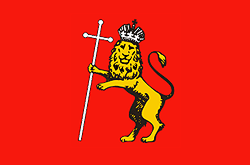
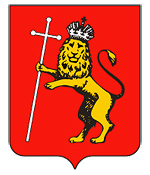
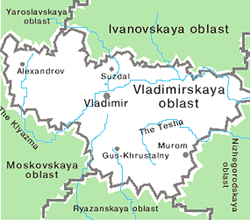



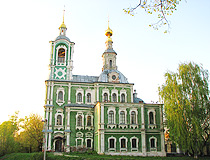

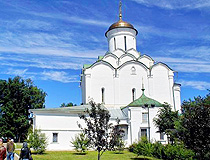
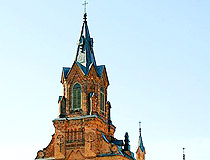
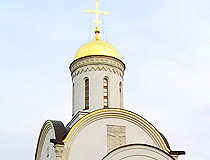
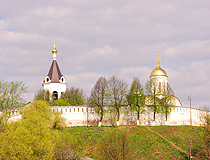

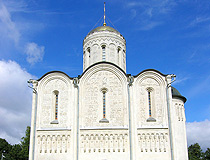
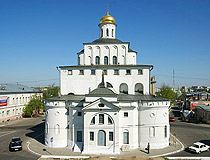
The comments of our visitors